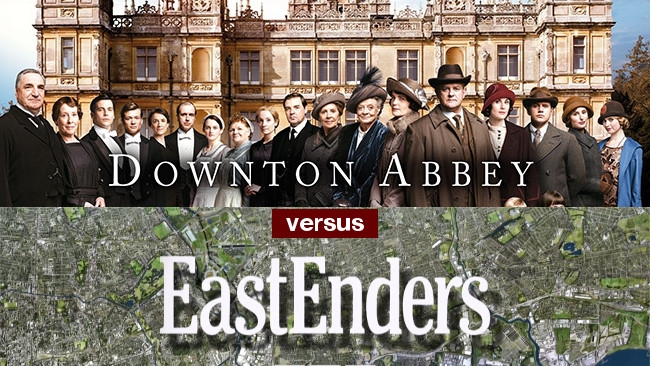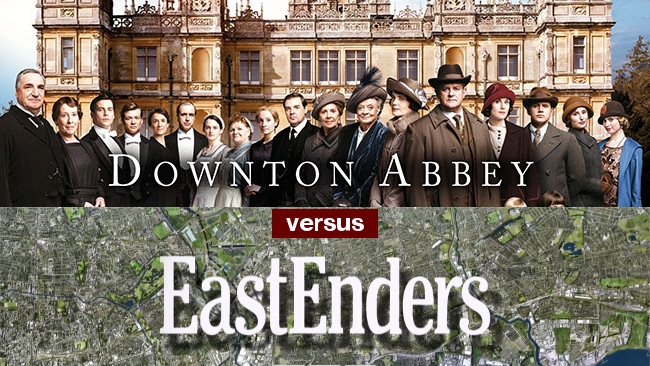
 Downton Abbey beats EastEnders in ratings battle
Downton Abbey beats EastEnders in ratings battle
Over the Christmas period in the UK, Downton Abbey beat EastEnders in the ratings, which could be seen as an indicator of what style of production both UK and American audiences prefer.
Speaking as an enthusiastic television snob, I couldn't possibly be more pleased at the news that lush period drama Downton Abbey soundly beat the BBC's decades-old soap EastEnders 6.6 to 5.7 million viewers respectively in the traditional festive TV ratings war.
It is, of course, commonly contended that Downton has (or, now, had) decidedly soap-operatic undertones, or even overtones, but that's actually quite an illustrative realisation which has a lot to say about what we're actually aiming for when we produce film and television. The popular press doesn't usually talk about the pictures very much, so when the New York Times says things like "the cinematography is exquisite," something special is generally going on – and that's not something that will ever be said about EastEnders, much as there's equally valuable, though wholly different, skill in that sort of production, too. It's easy to write these considerations off as simply money buying results, which to some extent they are, but there has to be a certain level of intent involved, and the intent behind Downton Abbey is identifiably part of a track record. If we're willing to risk a small criticism, there are ways in which it's also a straightforward assembly of elements to create something for which there is a market.
Following the Hollywood standard
These things are quite considered. Downton Abbey is a period piece, at least in part, because Americans will tolerate British drama so long as it's well-produced and set in a historical context, which goes some way to justifying the production and the financial input of NBC Universal via its ownership of Carnival. The involvement of Carnival is in some ways the motivation for this discussion, because its approach has long been similar (and similarly successful). Carnival's achievements to date include a huge amount of widely-respected television, from 1989's Traffik (upon which the 2000 Soderbergh film of almost the same name is based), through Jeeves and Wooster, the action-adventure-sci-fi BUGS which famously made a fortune internationally and, more recently, Whitechapel and Hotel Babylon.
I can't pretend to have any insider knowledge on how these big production companies work, but from out here, to someone not directly involved in the business and politics side of TV production, Carnival appears to be doing something that a lot more UK outfits could stand to do more: they're producing output that's on a par with upscale American dramas, competing directly and, generally, by doing very fine work. Yes, frequently, the concepts are frankly fairly off-the-shelf – high-tech crimefighting, as seen in BUGS, is something that's regularly regurgitated by the world of commercial film and TV, perhaps most recently as the various CSIs, which are as much science fiction as BUGS was. Downton Abbey, to be as cynical as possible, is an upstairs-downstairs soap opera that's had a lot of money thrown at it. Its success, though, belies that cynicism.
Relevance of craft
Why is this relevant to us? Because it provides a demonstration, in a world suffused by YouTube and national broadcasters happy to transmit portrait-mode cellphone video because content-is-king, that no matter how good, or how convenient, the tech gets, traditional skills remain relevant. There are always experimental filmmakers who are happy to shoot Tri-X pushed two and embrace the resulting ball pond of grain or Hi-8 holdouts clinging desperately to von Trier's now increasingly dated coattails and, in a pure artform, anything is as relevant as the justification for doing it. Nonetheless, most people have at least a sneaking admiration for anyone with the ability (not to say the resources) to create material that's seen as high-end by the commercial audience. Those of us making (or interested in making) money behind the camera are often professionally interested in little else.
I'm not here to say that Downton is EastEnders in an expensive suit – well, only to a very limited and carefully considered extent. I'm also not pursuing an agenda that takes anything away from EastEnders, the production of which is an expression of hard-won skill of studio production that often becomes invisible and underestimated. The difference is also, to some extent, a matter of intent and that's interesting because there are arguments that the more stylised something becomes, the more removed it becomes from reality. EastEnders works on whatever level it works because it feels like it takes place in the real world. Period drama glories in the exact opposite (you'd be forgiven for thinking that being a below-stairs servant in the titular Abbey was a fun and engaging life), but that really just makes production value even more core to the way it works. If you like these sorts of arguments, you have all the licence you need to decry this entire discussion on the basis that Downton Abbey and EastEnders aren't on any level comparable.
But they are being compared, and very extensively, because on 25 December 2015 the key TV ratings battle in the UK was defined by the fight between them. The purpose of television production is to make things people will be entertained by, not to provoke academic discussion, and on this occasion, the hare beat the tortoise. And then Sherlock came along and blew them both out of the water, but that's another story.
Tags: Studio & Broadcast


Comments